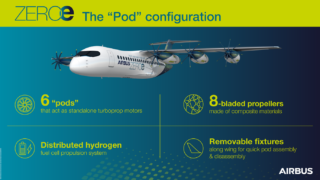-
Airbus considers hydrogen fuel cell ‘pods’ for its ZEROe concept aircraft
Date posted:
-
-
-
Post Author
Philip SharmanIFRF Director
-
-
![]()
In mid-December, pioneering aerospace company Airbus SE unveiled a new configuration as part of its ZEROe programme aimed at enabling passenger aircraft to fly farther than ever without emitting carbon dioxide.
The innovative approach consists of six, eight-bladed ‘pods’ mounted beneath the aircraft wing. While the ‘podded’ engine is not a new concept in aviation, these pods are not designed to be driven by any ordinary propulsion system: hydrogen fuel cells are among the key components.
“The ‘pod’ configuration is essentially a distributed fuel cell propulsion system that delivers thrust to the aircraft via six propulsors arranged along the wing,” explains Matthieu Thomas, ZEROe Aircraft Lead Architect. “Hydrogen fuel cells have very different design considerations, so we knew we had to come up with a unique approach.”
Indeed, hydrogen fuel cell technology has yet to be scaled-up to a passenger-size, large commercial aircraft. Smaller experimental hydrogen aircraft, comprising up to 20 seats, can rely on a traditional fixed-wing configuration with two propellers. But more passenger capacity and longer range require a different solution. This is why Airbus is studying a variety of configurations, including pods, to determine which option has the potential to scale-up to larger aircraft.
Each pod is essentially a stand-alone propeller propulsion system powered by hydrogen fuel cells. It consists of the following elements:
- propeller
- electric motors
- fuel cells
- power electronics
- liquid hydrogen storage tank
- cooling system
- auxiliary equipment.
Hydrogen and air are supplied to the fuel cells to generate electric current. Power electronics convert the current to power the electric motors, thereby turning the propeller.
Another striking feature of the pod configuration is its removable fixtures. This means each pod can be disassembled and reassembled in record time. This approach could provide a practical and rapid solution for maintenance and potentially hydrogen refuelling at airports.
The pod’s eight-bladed propellers, made of composite materials, are shaped to provide added thrust during the take-off and climb-out phases of flight. The advanced aerofoil design is expected to lead to improved efficiency and performance.
Although advanced in its design, the pod configuration still requires a lot of work to determine whether it could be a suitable solution. To date, it remains one of many exciting technology options that Airbus engineers are considering as they work towards launching the ZEROe programme.
“This ‘pod’ configuration is a great starting point to nurture further inquiry into how we can scale-up hydrogen technology to commercial aircraft,” Glenn Llewellyn, VP of Zero-Emission Aircraft, explains. “This is one option, but many more will be conceptualised before we make a final selection, a decision that is expected by 2025.”
A development area to watch with interest!

